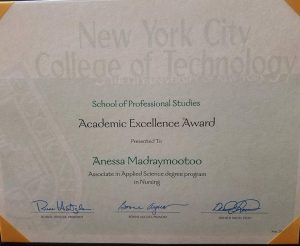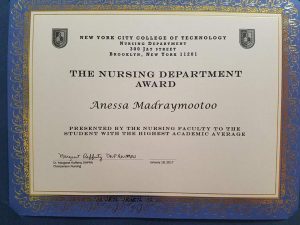The Nursing Shortage: It’s Causes and Potential Solutions
Anessa Madraymootoo
Professional Nursing Practice: NUR 4130 OL49
Professor Irene Pearlman
Fall 2018
November 12, 2018
Term Paper
The nursing profession has been one of great stature, trust and recognition throughout the years. Nurses serve as patient advocates, informants, educators, and sources of hope and support along their healthcare continuum. Yet despite this perception there is an extreme shortage of nurses to possess vital positions in the healthcare and in the educational systems. The passage of the Affordable Care Act pushes an additional strain and emphasis on the need for an adequate supply of nurses as about twenty million people have gained insurance coverage under the act in its first years (Uberoi, Finegold & Gee, 2016). The newly insured individuals will now seek medical attention in greater numbers in addition to the uninsured population that primarily use the emergency rooms as their primary care provider. Nurses are needed in large numbers not only due to the newly insured population but also due to the aging baby boomer population. These individuals will make visits to the hospital and other care settings that are anticipated in the later years of their lives and with chronic disease processes. The United States Bureau of Labor Statistics reported that by the year 2022 there will be a need for approximately 526,800 more registered nurses than any other profession in the healthcare field due to the changes seen in society (2018). Therefore, the nursing culture requires sufficient change and attention to retain and gain nurses to ensure optimal patient outcome, nurse to patient ratio and overall job satisfaction.
The nursing shortage is not a recent dilemma but it has been an area of concern for several years, however, multiple factors are driving the healthcare field closer and closer to the detrimental effects of the nursing shortage. To being with, the lack of nursing educators and other faculty members has a direct impact on the number of new nurses that are capable to enter the workforce. The American Association of College of Nursing released data that stated, nursing schools in the United States had to decline the entrance of 64,067 qualified students out of their programs due to lack of theory and clinical educators, clinical sites, sufficient classroom accommodation or funding for resources (2017). The lack of nursing departmental staff is unfortunate as there are numerous students eagerly waiting to pursue their goals of becoming a nurse. As the professors that are actively aging and sooner or later retiring, there will be a further decrease in the amount of nursing classes being held and an increase in students being turned away, though they are very much needed. Awareness must be raised about this type of nursing shortage as it has the potential to improve the nursing shortage long-term. The Lienhard School of Nursing at Pace University adapted multiple solutions to increase their faculty members, such as partnering with the Veterans Affairs New York Harbor Healthcare System which allowed nine qualified nurses to teach courses in the clinical and classroom setting after their skills and qualifications were reviewed by the programs chairperson (Feldman, Greenberg, Jaffe-Ruiz, Kaufman, & Cignarale, 2015). These nine members also received mentoring and support to ensure that they remained within the university as well as increase their confidence and competence levels. Students who were interested in becoming nursing educators were enlightened about grants that would allow them to obtain their masters in nursing education. Of the students fifteen were able to successfully complete the program and obtain their masters and four of the students were employed as full-time employees at the institution (Feldman et al, 2015). More colleges should implement such programs and incentives to guarantee adequate professors and nursing graduates which would lead to favorable working conditions. Also, nurses with degrees even at the bachelor’s level should strive for more advanced degrees to fill the nurse educator gap while taking advantage of grants and scholarships to lessen the financial burden.
An additional factor that has a direct influence on the nursing shortage is the bullying and feelings of incompetence that may flood the first few months of employment as new nurse. Placement after being hired can be not only emotionally straining but nerve wrecking as the textbooks prepare student for a perfect nursing world rather than the reality of being out in the field practicing. Often the first few weeks on the job, the nurse is on orientation with a few mentors or preceptors to guide the way and shower their knowledge and skill technique on the young nurse. However, not all mentors are supportive, encouraging or understanding to facilitate the new graduate nurse’s transition from school to the unit. Lisa A. Thomka conducted a qualitative study that consisted of sixteen registered nurses that were starting new jobs, each were given a chance to express their thoughts and ideas about their orientation process. Some nurses stated that their first weeks were extremely stressful (Thomka, 2001). They expected more support as eleven of the participants stated that their experience were terrible, as their preceptors were not patient, complaining to their managers, and were often criticized publically (Thomka, 2001). Such an experience can significantly alter ones confidence and self-esteem and can have a long term effect on ones long term productivity. Though years have passed since this study, such behavior and attitudes of the experienced, older nurses towards their younger less experienced nurses are still prevalent. Of the sixteen individuals in Thomka’s study, twenty-five percent of them thought about quitting because of how they were treated (2001). This should not be shocking, who would want to continue working in such a toxic environment where merely asking a question or voicing uncertainty will lead to embarrassment. New nurses are often taken advantage of as well, by having difficult assignments that should have instead been partitioned. Managers and experienced nurses need to realize that these new nurses are vital to achieve safer patient to nurse ratios and should treat them with respect and help to train them as if they were going to be their nurse somewhere along the road. If all the nurses who were treated poorly during orientation left, the nursing shortage will never be resolved. Everyone was a new nurse at some point in their lives. Experienced nurses should utilize reflective practice to ensure proper transition of the new nurses into the workforce and thereby put an end to workplace bullying. To be fair, not only are the newer nurses at a disadvantage some of the experienced nurses may also feel used and abused for their skills and expertise by the recent graduates to avoid heavy workload of critical patients.
Horton, DePaoli, Hertach and Bower suggests that preceptors could benefit from attending the Nurse Preceptor Academy which helps the attendees to develop the qualities and skills of an effective preceptor, such as the ability to give constructive feedback, establishing weekly goals, evaluating progress, communication skills, and teaching skills (2012). Of the 714 participants 63 percent stated that after attending the workshop they were able to effectively establish goals and evaluate their preceptees and that they felt more prepared and satisfied with their role as a preceptor (Horton et al, 2012). Similarly, researchers, Lee, Tzeng, Lin and Yeh, gathered data during their quasi experiment that showed a correlation between nurses attending such programs and a decrease in the nurse turnover rate by 46.5% when compared to the previous year as well as increased preceptees satisfaction of their preceptors and decreased medication errors and adverse incidents on the units (2009). Hospitals across the globe should adopt this approach to retain staff thereby attempting to lessen the nursing shortage on their units, as new team member will feel appreciated, supported and encouraged to continue. Adequate staff is essential to ensure optimal patient satisfaction and lessen the strain on nurses when there is lack of staff.
The lack of nurses on units leads to heavy workloads. High patient to nurse ratios add to the stress and immense responsibility and tasks that each individual has to complete. Many of the older nurses are approaching retirement age, passing the throne to the younger generation of nurses, yet many aspiring nurses and new graduates are not given an adequate chance. As mentioned before leave soon after or during orientation due to the harsh workplace condition and environment, lack of confidence, feelings of incompetence and extremely high expectations of the title, while lack of faculty and clinical settings creates barriers for nursing students. Thereby leaving the nurses who are currently in practice tired, fatigued and burned out due to mandatory overtime, overall work-related stress by having large patient assignment. Many nurses may skip lunch breaks and may not even take to the time to the bathroom putting their patients first while risking their own health and well-being. Unsafe patient ratios can lead to job dissatisfaction, poor coping behaviors and improper workplace composure leading to arguments and write-ups. These behaviors and situations contribute to the high turnover rates that are prominently seen within the nursing profession.
To improve the nursing shortage seen on units a vast amount of information can be taken and implemented from the nurse staffing mandate enforced in California. This form of legislation established that nurses on medical surgical units can have a maximum of five patients. Aiken, Sloane, Cmiotti, Clarke, Flynn, Seago, Spetz and Smith obtained surveys from nurses in California and compared that data to the surveys completed by nurses who worked in Pennsylvania and New Jersey where there was no limit on nurse to patient ratios (2010). It was concluded that the mandated ratios lead to decreased nurse burnout rates, job dissatisfaction, quitting rates as well as an increased workplace environment and quality of performance and patient care (Aiken et al, 2010). Nurses and other leaders in the healthcare system should voice and advocate the need for such implementation across the states. Nurses may be more pleased with their clinical and professional work and may not be as stressed and tired as there currently are without the mandate. Nurses may then have the energy and drive to strive for higher degrees to fill the positional gaps as nursing education faculty members to educate a newer generation of nurses. With the mandate nurses will have manageable assignments and task to complete during their shifts and lessen the chances of feelings of overwhelm, thereby increasing their patience and ability to train new employees.
Nurses are critical and fundamental to the health and well-being of patients throughout their healthcare continuum, especially while the client is hospitalized for acute stages of illness and disease processes. It is mournful that after all these years there is still a nursing shortage which includes educational faculty and employed nurses. These circumstances are horrid for those actively employed as well as the patients, as there is not enough time and attention allotted to their care or change in condition. Nurses and nursing students should advocate for the interventions mentioned throughout, such as increased grants to fund higher degrees to bridge the nurse faculty gap, nurse residency programs to enhance skill competence, as well as the preceptor training program to ensure staff recruitment and retention and decrease displeasure. Enforcing mandates like California’s can also help by bringing back nurses who felt that the workload was too much to manage and also help keep older, more experienced nurses employed rather than having them retire early. Nurses need to make their voices heard, patients all over the world depend on their nurses to care, advocate, educate and ensure that their healthcare goals, needs, want, and desires and met. Nurses are the hearts of the healthcare profession and without a doubt are needed in great quantity and quality.
References
Aiken, L. H., Sloane, D. M., Cimiotti, J. P., Clarke, S. P., Flynn, L., Seago, J. A., Spetz, J., & Smith, H. L. (2010). Implications of the California nurse staffing mandate for other states. Health Services Research, 45(4), 904–921. https://doi-org.citytech.ezproxy.cuny.edu/10.1111/j.1475-6773.2010.01114.xFeldman, H. R.,
Greenberg, M. J., Jaffe-Ruiz, M., Kaufman, S. R., & Cignarale, S. (2015). Hitting the Nursing Faculty Shortage Head On: Strategies to Recruit, Retain, and Develop Nursing Faculty. Journal of Professional Nursing, 31(3), 170–178. https://doi-org.citytech.ezproxy.cuny.edu/10.1016/j.profnurs.2015.01.007
Horton, C. D., Depaoli, S., Hertach, M., & Bower, M. (2012). Enhancing the Effectiveness of Nurse Preceptors. Journal for Nurses in Staff Development, 28(4). doi:10.1097/nnd.0b013e31826385b9
Lee, T., Tzeng, W., Lin, C., & Yeh, M. (2009). Effects of a preceptorship programme on turnover rate, cost, quality and professional development. Journal of Clinical Nursing, 18(8), 1217-1225. doi:10.1111/j.1365-2702.2008.02662.x
Nursing Faculty Shortage. (2017). Retrieved from https://www.aacnnursing.org/News-Information/Fact-Sheets/Nursing-Faculty-Shortage
Registered Nurses. (2018, April 13). Retrieved from https://www.bls.gov/ooh/healthcare/registered-nurses.htm
Thomka LA. (2001). Graduate nurses’ experiences of interactions with professional nursing staff during transition to the professional role. Journal of Continuing Education in Nursing, 32(1), 15–19. Retrieved from http://citytech.ezproxy.cuny.edu:2048/login?url=http://search.ebscohost.com/login.aspx?direct=true&db=ccm&AN=107016758&site=ehost-live&scope=site
Uberoi, N., Finegold, K., & Gee, E. (2016, March 3). Health Insurance Coverage and The Affordable Care Act, 2010–2016. Retrieved from https://aspe.hhs.gov/system/files/pdf/187551/ACA2010-2016.pdf.
**ACHIEVEMENTS**





